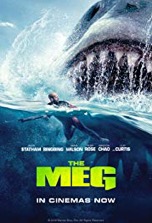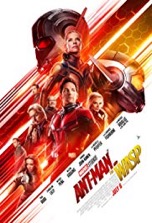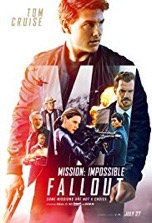August 2018
The Meg (PG-13)
22/08/18 22:12 Filed in: 2018

Starring: Jason Statham
August 2018
Warning! This is NOT a movie review. This is a critique of the film. Intended to initiate a dialogue, the following analysis explores various aspects of the film and may contain spoilers. Views are my own and elaborate on comments that were originally tweeted in real time from the back row of a movie theater @BackRoweReviews. For concerns over objectionable content, please first refer to one of the many parental movie guide websites. Ratings are based on a four star system. Happy reading!
“There’s always a bigger fish.” – Qui-Gon Jinn, Star Wars: Episode I – The Phantom Menace (1999)
Qui-Gon’s wry comment is perfectly illustrated by one of the movie posters for The Meg, the new deep sea thriller from director Jon Turteltaub (National Treasure), which depicts the terrifying tableau of a diver swimming toward the surface who is being pursued by a great white shark which is stalked by a massive megalodon (technically, carcharodon megalodon, a supposedly extinct mega-shark that serves as the movie’s ubiquitous threat). Simply put, it’s eat or be eaten out on the open water. Our “supersize” mentality has permeated every segment of society, ranging from value meals to movie monsters. This is particularly true of thriller franchises like Jurassic Park where the T-Rex was replaced by the Spinosaurus, which was supplanted by the Indominus Rex which was superseded by the latest bigger/faster hybrid introduced in the recent Jurassic World: Fallen Kingdom (which I won’t spoil in case you haven’t seen it yet). Instead of starting off with a great white shark and working up to a larger predator, the movie goes right to its supersized antagonist, the megalodon. The movie opens with an ill-fated rescue mission, where Jonas Taylor (Jason Statham) makes a difficult judgment call that condemns half his crew to a watery grave after the ship is attacked by what he later describes as a 70-foot creature. Five years later, after losing his career and marriage, Jonas is a guilt-stricken alcoholic who has sworn off diving for the rest of his life. Jonas’ pity party is interrupted when pal Mac (Cliff Curtis) and Mana One underwater station supervisor Dr. Zhang (Winston Chao) show up to enlist his help on another rescue mission. Jonas is adamant about not getting involved until Mac reveals the identity of the person trapped inside the disabled submersible, which is rapidly running out of air…Jonas’ ex-wife. And I’ll give you one guess as to what damaged the sub and lies in wait for Jonas at the bottom of the ocean. As would be expected for a summer creature feature, the movie is packed to the gunnels with stock characters. Statham is the reluctant hero. Bingbing Li is the love interest. Rainn Wilson is the unscrupulous business tycoon with no respect for people and no reverence for nature. Ruby Rose is the uber-smart techie. Page Kennedy is the comic relief. Robert Taylor (who is solid as usual, but seems miscast here) is the cool under fire doctor. Shuya Sophia Cai steals the show as precocious youngster, Meiying. The real star of the show, of course, is the giant shark. The sheer immensity of the creature is breathtaking. And yet, even though the leviathan is undeniably imposing, there’s something lacking in this terror from the deep…some aspect that prevents it from inducing the same level of bloodcurdling dread that the violently thrashing creatures showcased in earlier shark movies did to a superlative degree. Maybe it has something to do with the way Turteltaub frames the super-shark. Or maybe it’s the photo-realistic CGI that’s so finely rendered that it leaves nothing to the imagination. Say what you will about Steven Spielberg’s animatronic shark in Jaws (1975), it was downright terrifying. The less-than-impressive title creature leaves us with a lingering question: how is it possible that something so gigantic, so powerful, and so quick can be so unconvincing? One of the major reasons why the megalodon fails to frighten is that the story, written by Dean Georgaris, Jon Hoeber and Erich Hoeber (based on the novel MEG: A Novel of Deep Terror by Steve Alten), has no teeth. The story is highly imitative of the Jaws series and the many cheap knockoffs it inspired: Deep Blue Sea (1999), Megalodon (2002), Sharknado (2013) and The Shallows (2016), to name just a few. With the subgenre’s tropes so well-defined at this point, it’s almost impossible to make a shark attack film without being derivative, and The Meg is no exception. The scene where the giant fish approaches the teeming Chinese beach is reminiscent of the initial shark sighting at the beach on Amity Island in the first Jaws film. Someone needs to inform the writers that humans don’t taste good to sharks, and that all the people in the water would only serve as an appetizer to the colossal creature. Plus, as one scene slyly visualizes, clothing, snorkels, flippers, etc get lodged in between the megalodon’s massive teeth…and there’s no such thing as shark floss. Though the crew pursues the megalodon in a big boat, it turns out they need an even bigger one, which, of course, is a tip of the hat to the famous line in the first Jaws movie. Mana One station is a high-tech, less commercial version of SeaWorld Orlando’s underwater tunnels in Jaws 3-D (1983). Also, there’s more than a passing resemblance between Jonas firing a spear-like weapon with a tracker at the whale-sized shark and Captain Ahab hurling a harpoon at the white whale in Moby-Dick. Suffice it to say, the list of comparisons between The Meg and other shark films is expansive. The one thing the story does right is pacing. The ratio of character beats to action scenes is surprisingly well-balanced for a horror/thriller flick. In the end, The Meg is a disappointing effort that feels more like a big budget Syfy channel movie than a major studio tentpole. Even when characters are face-to-face with the megalodon, the movie has a strange lack of peril. Still, The Meg delivers exactly what it promises…a summer popcorn flick that boasts a generous number of adrenalin-pumping chases and close calls with rows and rows or razor-sharp teeth. So, will there be a Meg 2 and if so, how will they outdo the mega-shark in this film? Or, to put it a different way, how can you supersize a megalodon?
Rating: 2 out of 4 stars
Ant-Man and the Wasp (PG-13)
22/08/18 22:07 Filed in: 2018

Starring: Paul Rudd
July 2018
Warning! This is NOT a movie review. This is a critique of the film. Intended to initiate a dialogue, the following analysis explores various aspects of the film and may contain spoilers. Views are my own and elaborate on comments that were originally tweeted in real time from the back row of a movie theater @BackRoweReviews. For concerns over objectionable content, please first refer to one of the many parental movie guide websites. Ratings are based on a four star system. Happy reading!
One of the subplots in the first Ant-Man (2015) revealed that scientist Hank Pym (Michael Douglas) lost his wife Janet (Michelle Pfeiffer) when she went subatomic to disable a Soviet nuclear missile, a heroic deed that relegated her to being tossed about inside the swirling maelstrom of the quantum realm for all eternity. The sequel, Ant-Man and the Wasp, opens with that fateful mission (these archival clips from the first film set the tone for the sequel’s rehashed sameness), which effectively kicks off the action and establishes the movie’s premise as a straightforward rescue tale. Since the last film, Hank has been busy building a quantum tunnel. Hank prevails upon Scott Lang/Ant-Man (Paul Rudd) to enter the subatomic dimension and rescue Janet. Other than a few character beats and a handful of action sequences, that’s pretty much the whole plot in a nutshell. The Ant-Man franchise is like the redheaded stepchild of the Marvel universe. Compared to the Avengers series, this film feels downright low budget. Like Scott, who is under house arrest (a story element that quickly tires), the movie is firmly moored to its San Francisco locations. Whether intentional or not, the film’s insular framework is symbolic of the confinement Scott and Janet have been forced to endure. The story by Rudd and four other writers is rote and seems more like an episode of Agents of S.H.I.E.L.D. than a big budget summer tentpole. With a dearth of character development and reheated dialog, the movie’s central figures are merely caricatures of themselves, especially Luis (Michael Pena), whose one-liners are as stale as last week’s pizza. The rest of the actors do what they can with mediocre material. This is a sad fact since the movie boasts some impressive actors, including: Walton Goggins, Bobby Cannavale, Judy Greer and Laurence Fishburne. For this outing, Scott is joined by Hope van Dyne (Evangeline Lilly), who takes her mother’s mantle as the Wasp. Other than watching the duo kick some major tuchus in a couple action scenes, the only aspect of the film that’s enjoyable is the loving relationship between Scott and his daughter Cassie (Abby Ryder Fortson). The homemade ant farm inside the house is a creative and thoroughly enjoyable scene. Another clever concept is how Hank’s lab can shrink down to the size of a milk crate so that it can be transported to another locale and enlarged back to its skyscraper proportions. The mobile tower concept was also used to great effect in the fantasy/sci-fi cult classic Krull (1983). The FX inside the quantum realm are a major disappointment…any decently produced TV show can achieve, and in many cases supersede, these multicolor miasma effects. The blurry ghost image employed whenever Ava/Ghost (Hannah John-Kamen) time shifts is a really well conceived and executed visual effect. In the end, Ant 2 is a safe and predictable follow-up to the first film, which was a surprise hit. The only surprise here is how uninspired the story is. For Ant-Man 3, Marvel had better step up its game. Otherwise, they might discover that, like their titular hero, the audience can shrink too.
Rating: 2 ½ out of 4 stars
Mission: Impossible - Fallout (PG-13)
02/08/18 00:18 Filed in: 2018

Starring: Tom Cruise
July 2018
Warning! This is NOT a movie review. This is a critique of the film. Intended to initiate a dialogue, the following analysis explores various aspects of the film and may contain spoilers. Views are my own and elaborate on comments that were originally tweeted in real time from the back row of a movie theater @BackRoweReviews. For concerns over objectionable content, please first refer to one of the many parental movie guide websites. Ratings are based on a four star system. Happy reading!
Even though this is the sixth movie in the series, Mission: Impossible - Fallout has many firsts. This is the first MI movie to be released in 3-D (RealD 3D). Christopher McQuarrie has become the first MI director to call the shots on more than one film in the franchise. And while on the subject of firsts, Rebecca Ferguson, who plays MI6 agent Ilsa Faust, is the first female to appear twice in a leading role in a MI film (also noteworthy is that she was pregnant while filming her scenes). At age 56, Tom Cruise is in amazing physical shape and still looks credible as an action star (unlike Roger Moore in his later James Bond movies). Cruise’s devotion to his craft is remarkable and his stamina is undeniable, especially since he continues to do most of his own stunts. Cruise trained for a year in order to pull off the HALO (High Altitude, Low Opening) parachute jump in the movie. Since the scene takes place near sunset, Cruise and crew could only attempt one jump per day. With the assistance of a C-17 military aircraft and a ground crew to create a vertical wind tunnel, Cruise made over one hundred jumps at 25,000 feet just to deliver three shots for McQuarrie to use in the film. Now that’s dedication! Not all of Cruise’s stunts were successful, though. In a scene where he jumps from one building to another, Cruise fractured his ankle, which delayed shooting for nearly two months. Weighing in at 2 hours and 27 minutes, MI6 has a longer running time than any previous film in the series. Unfortunately, it’s about 27 minutes too long. That comment is no disparagement of the movie’s action sequences, which are innovative, wildly entertaining and, along with Cruise and Henry Cavill, the main draw of the film. If MI6 were to be judged solely on its high-octane action scenes, it would be a 4 star film. However, in a summer blockbuster jam-packed with mind-blowing stunts, it’s easy to mistake spectacle for quality. Despite having some of the finest pulse-pounding stunts in the entire series, this is a lesser MI film, thanks to McQuarrie’s flaccid screenplay. The passé premise (the 80s spy movies called and want their plutonium back), trite dialog (“Family…what can you do?”) and languid storytelling (especially in the early stages of the film) are all narrative ailments the film can’t quite overcome. That’s not to say that the film doesn’t have a plot…it does; a very straightforward, predictable and contrived one. People from Hunt’s past pop up at regular intervals with little explanation or preamble. Erica Sloan’s (Angela Bassett) backhanded comment about IMF agents treating every day like Halloween is amusing and incisive. Ironically, the movie fails to take its own hint since the mask gag is overused here. The down-to-the-last-second bomb disarming is a hackneyed story element that, thankfully, is delivered with a little self-reflexive humor here. McQuarrie trots out the tired “mole inside the operation” plot device in an effort to muddle the motivations of Hunt (Cruise) and Walker (Cavill), but the shocking reveal is obvious from the start. And why did Hunt and Walker have to parachute from a high altitude (a similar sequence appears in 2009s Star Trek), through a lightning storm no less, just to land on the roof of a Parisian building they could’ve gained access to with a proper disguise? Maybe it’s because we get a show-stopping stunt sequence out of the deal or because the rapid plummet ties in with the movie’s title—the theme of personal and physical descent permeates the story. All things considered, MI6 is a decent actioner with solid performances, stellar directing and mind-blowing cinematography. The location work, particularly the scenes shot in London, Paris and the United Arab Emirates, is truly exceptional and effectively simulates the continent-hopping narrative of a James Bond film. The one thing the MI films have consistently done right, and probably one of the major reasons why people keep turning out to see them, is that each new film ups the ante with its jaw-dropping, gravity-defying stunts and action scenes (like a modern-day Houdini, Cruise is a magician who keeps topping his previous death-defying feats). The last half hour of this film contains a chain of top-notch, heart-stopping action beats that will literally leave you gasping for air. If you can get past the “same ole” plot elements, MI6 is a riveting, thrilling popcorn flick that ends with a cliff-hanger and seems destined to be followed by another sequel.
Rating: 3 out of 4 stars